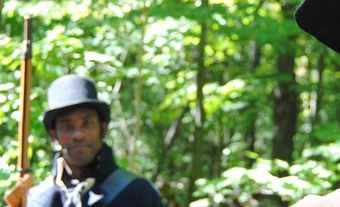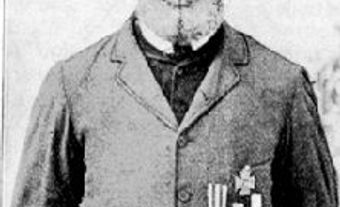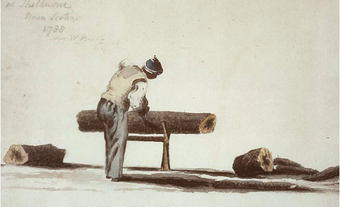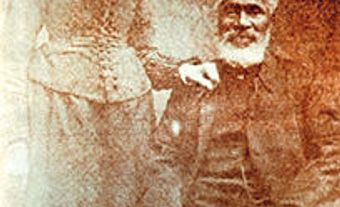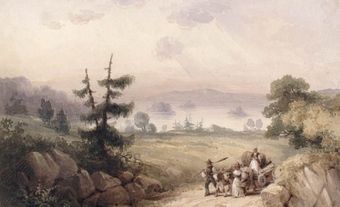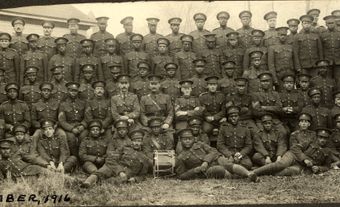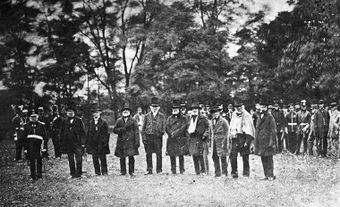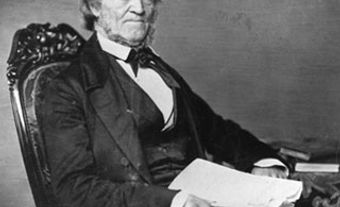Black soldiers served in military units throughout the 19th century in Canada. Although some (white) commanding officers rejected Black volunteers, they served in the militia in integrated units and in Black units such as the Coloured Corps in Niagara, the Victoria Pioneer Rifle Corps in British Columbia and the Victoria Rifles in Halifax, Nova Scotia. Black soldiers served in peacetime and in major events such as the War of 1812 and the Rebellions of 1837–38.

Sedentary and Volunteer Militia
From 1800 to 1867 all men were required to serve in the “sedentary militia.” (See Militia Acts and History of the Armed Forces in Canada.) In Upper Canada/Canada West and Lower Canada/ Canada East, Black men could serve in their local militia in integrated units. This was not the case in Nova Scotia and New Brunswick, where Black men had to serve in segregated units attached to the local regiment. The “sedentary militia” regiments only paraded a couple of times year. Citizens also organized volunteer units for those who wanted extra training. Service with these volunteer units was unpaid, and the officers decided who could serve. Some Black men were accepted in integrated units, but there were also Black volunteer units throughout the 19th century. The Black community at Sandwich, for example, formed a volunteer militia corps in 1826.
War of 1812
During the War of 1812, Black men served in integrated units and in an all-Black unit known as the Coloured Corps. The unit had been suggested just before the war by Richard Pierpoint, a formerly enslaved person and Black soldier who had served with Butler’s Rangers, a Loyalist unit, in the American Revolution. General Sir Isaac Brock initially rejected the idea but changed his mind after the American occupation of Sandwich (Windsor) on 12 July 1812. The unit was authorized on 28 August, with command given to Captain Robert Runchey, a white officer with the 1st Regiment, Lincoln Militia.
First known as “Captain Runchey’s Company of Colored Men,” they fought at the Battle of Queenston Heights on 13 October 1812. After some initial skirmishing, the Colored Men fired a volley before charging the American forces. After that battle they were renamed the Coloured Corps and stationed at Fort George. When the Americans landed near Fort George on 27 May 1813, they were among the troops who rushed to the beach and fought the attackers at a range of less than 10 metres, suffering five casualties out of only 27 men in the company. By 1814, the unit had been converted to an engineer unit and helped build Fort Mississauga. The Coloured Corps was disbanded on 24 March 1815.

Black militiamen also served in integrated units, sometimes in distinct companies. The 104th Regiment of Foot from New Brunswick was a British regiment recruited locally. The regiment’s pioneers, or engineers, were all Black soldiers. When the 104th Regiment trekked from Fredericton to Kingston from mid-February to mid-April 1813, the Black pioneers led the way, preparing the camps where the troops would stay each night when other accommodation was unavailable. The 104th was active across Upper Canada in 1813 and 1814. As the regiment was unable to find enough soldiers to replace its casualties, it is likely that the Black pioneers were pressed into combat. At least one Black soldier from the 104th Foot was transferred to a veterans battalion because of injuries and fatigue.
In Lower Canada, the Voltigeurs de Quebec enlisted at least nine Black soldiers from Montreal. Some enlisted before the United States declared war. By October 1814, one had been promoted to sergeant, which was unusual for Blacks in integrated units at that time. Many of these Black soldiers participated in the Battle of Châteauguay on 26 October 1813. At least three Black men also served in the Select Embodied Militia in Lower Canada.
Rebellion of 1837–38
During the Rebellion of 1837–38 in Upper Canada, Black men were part of integrated units and also formed their own authorized Black units, which were usually led by white officers. The first Black units were authorized in December 1837 but disbanded in February 1838, when the rebel threat declined. Another seven Black companies were authorized in October 1838 when rebel activity increased. Most of these units were disbanded in April 1839.
As with white companies, their main task was guarding vital points such as bridges although they occasionally saw action. Fifty Black soldiers helped defeat a rebel force that landed near Windsor on 3 December 1838. The longest lasting of these Black companies was another “Coloured Corps” that served as police in the 1840s during the construction of the second Welland Canal, among other tasks. It was disbanded at the end of April 1850.
One of the more notable Black units was led by Josiah Henson and attached to the 2nd Essex Regiment. Henson’s company participated in the attack on the rebel schooner Anne and then helped protect Fort Malden, which it did from Christmas until May 1838. Unlike the Coloured Corps, Henson’s company wasn’t officially authorized as a Black unit.
Black Volunteer Units
After the Rebellion of 1837–38, volunteer units became the main form of militia service in Upper Canada/ Canada West. The volunteers were better trained and more efficient, although the sedentary militia remained the approved form until the Militia Act of 1854 (New Brunswick followed in 1862). In the 1850s, the lieutenant governor of Canada West approved the formation of Black volunteer units. In 1852, a Black militia unit from Amherstburg was “given the right of the line of march” during the Emancipation Day parade in Windsor. The same year, however, a white mob attacked a parade of Black militia in St. Catharines, and then targeted Black property in the city.
In April 1860, a group of Black immigrants from California formed the Victoria Pioneer Rifle Corps on Vancouver Island. It is widely considered the first British or Canadian military unit formed west of Ontario. The unit was approved by Governor James Douglas in 1860 but disbanded in 1865, after the next governor, Arthur Edward Kennedy, stated he would not accept any military unit based on class, colour or nationality.

Another Black volunteer unit was formed in Halifax, Nova Scotia, on 4 February 1860. The Victoria Rifles were one of the volunteer units on parade when the Prince of Wales visited Halifax in August 1860. (See Royal Tours and 10 Memorable Royal Tours of Canada.) Although the Rifles demonstrated considerable skill and were described in the local press as being very well turned out, they were denigrated by white militia leaders and other community notables. It had disbanded by 1864.
Fenian Raids, 1866
Between 1866 and 1871 the Fenian Brotherhood, an Irish independence movement, launched a series of small, armed attacks into Canada. On 2 June 1866, the Canadian Militia fought the Fenians at the Battle of Ridgeway. After the battle, a Black volunteer unit from St. Catharines escorted Fenian prisoners on the train trip to a prison at Brantford. They not only had to keep the prisoners from escaping but also protect them from the local population along the route from the train station to the jail.
From Confederation to the First World War
The Canadian Militia Act of 1868 relied upon volunteer regiments as the basis for a military service. The act did not restrict the enlistment of Black men, but many commanding officers rejected Black volunteers. Some were accepted, however, and served in Canada’s official militia regiments. Many Black soldiers who enlisted in the First World War had either served in these regiments or had parents who had served. There were also some Black volunteer regiments in post-Confederation Canada, although they were not officially part of the country’s military forces. Windsor, for example, had a Black volunteer militia that turned out for a Labour Day parade in 1897 but had not been sanctioned by the government. Such units were part of a long history of volunteer military service by Black men in Canada.

 Share on Facebook
Share on Facebook Share on X
Share on X Share by Email
Share by Email Share on Google Classroom
Share on Google Classroom
